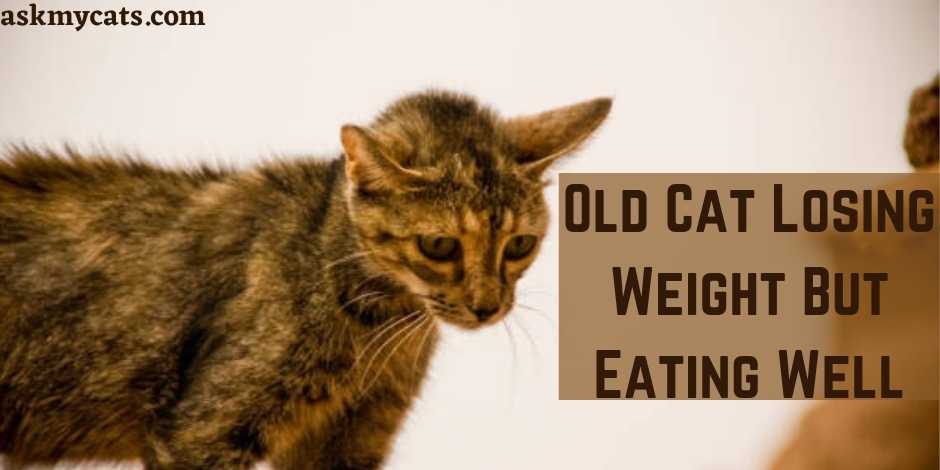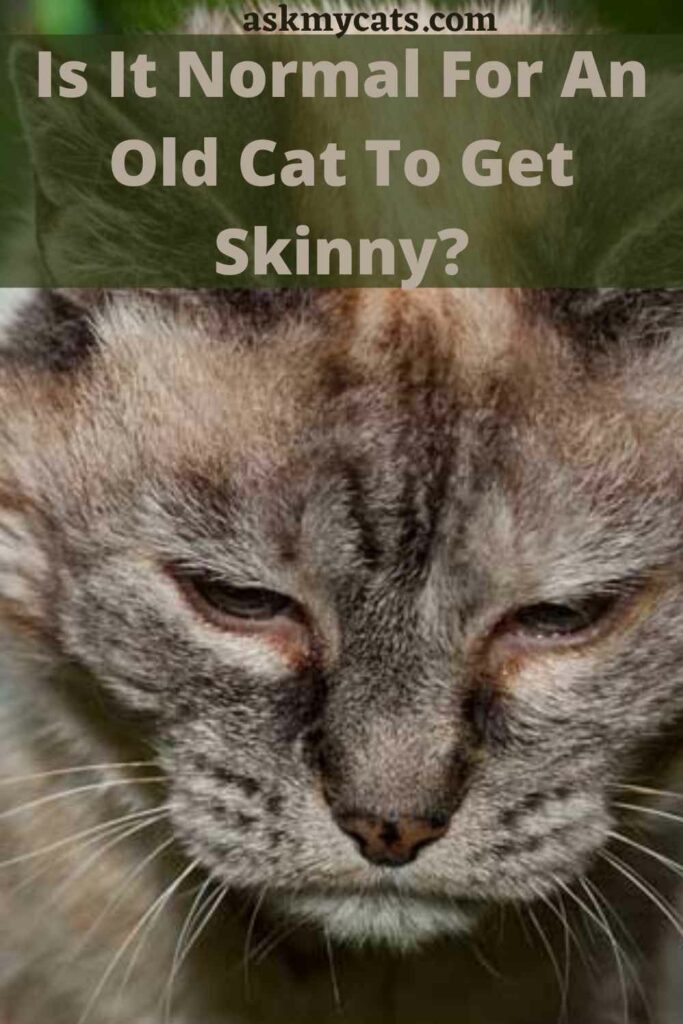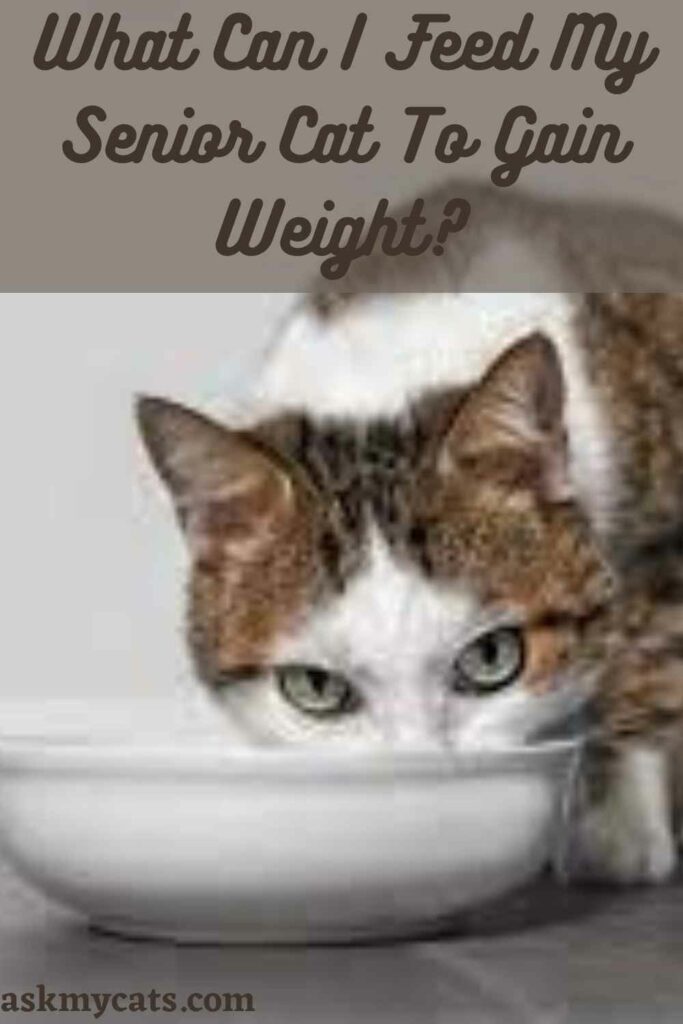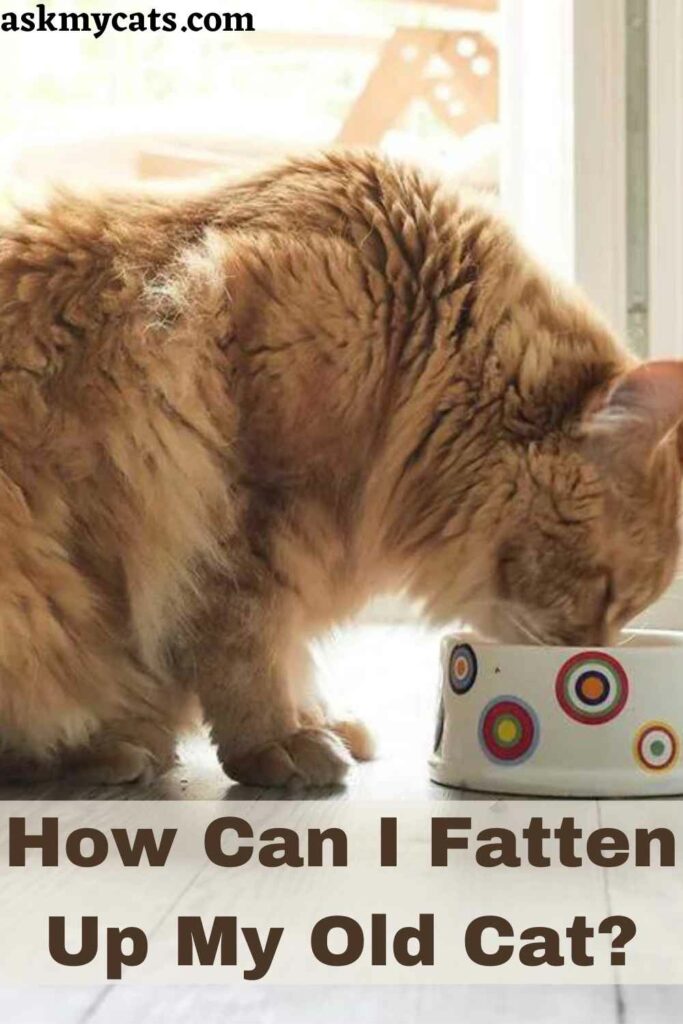You’re concerned as a cat owner. Your old cat’s chubby tummy has vanished, and there is now a visible waist behind the ribs. You can see and feel your cat’s ribs, which you couldn’t before, and your cat’s back is bony now, where it was smooth before.
So, why is your old cat losing weight despite eating well?
The reason behind your old cat losing weight despite eating well is that it is usually is common in cats older than 11 years of age.
This article will talk about the reasons behind your old cat losing weight and how can you help it gain weight.


Give Your Cat the Perfect Day
Get the Free Ebook!
Is It Normal For An Old Cat To Get Skinny?
Yes, it is normal for an old cat to get skinny.

Bodyweight loss is common in cats over the age of 11 years.
This loss is sometimes easily attributed to obvious disease, but in many cases, there are no obvious signs of illness and routine diagnostic approaches fail to reveal evidence of an underlying problem.
Energy requirements in older cats do not appear to decline as sharply as they do in dogs and humans, possibly because physical activity in cats does not decline as sharply with age.
Indeed, the energy requirements of older cats may increase rather than decrease.
Although cats are expected to adjust their energy intake to compensate for these changes in order to maintain body weight, this is clearly not always the case.
For many years, it has been recognized that the digestibility of protein and fat decrease in many seemingly normal cats after the age of ten.
While the cause of the decreases is unknown, the changes are quite noticeable in some individuals and can be quite dramatic in terms of fat digestibility.
These changes are frequently not obvious from casual observation of feces and may only be confirmed if the fecal fat content is quantified using appropriate analytic testing.
Methods for such testing are rarely available for veterinary patients’ evaluation, even at referral centers.
Whatever the cause of weight loss and decreased nutrient digestibility in older cats, progressive weight loss has been reported in the two years preceding death from a variety of seemingly unrelated diseases. This weight loss is becoming more common as cats live longer lives and receive better health care.
Attributable Weight Loss
Chronic renal disease, diabetes mellitus, hyperthyroidism, inflammatory bowel disease (IBD), exocrine pancreatic insufficiency, and dental problems are all well-known causes of weight loss in old cats.
Physical examination and routine laboratory testing can easily detect and confirm the majority of them.
Additional testing of parameters such as serum thyroxine, serum trypsin-like immunoreactivity, cobalamin and folate, dental radiography, or gastrointestinal (GI) endoscopy and biopsy may be required at times.
Despite extensive investigation, the underlying cause of even severe weight loss can be exceedingly difficult to establish conclusively.
Unattributed Weight Loss
Subtle weight loss may not be detected unless meticulous records of body weight and body condition scores are kept over multiple veterinary examinations.
Similarly, moderate increases or decreases in food or water intake are likely to go unnoticed by the majority of owners.
Even when the most conscientious owners provide the best veterinary care for their cats, a significant proportion of senior cats will lose weight, despite appearing to be in good health and no discernible change in food intake.
There is evidence to suggest that there is an age-related decline in food digestibility in these older cats with no obvious classic diseases to explain the weight loss.
Age and fat digestibility have a significant (p.0001) negative correlation (r = 0.76). The prevalence of low-fat digestibility increases with age, affecting 10% to 15% of mature cats (8–12 years of age) and 30% of geriatric cats (>12 years of age).
Fat digestibility was found to be as low as 30% in some geriatric cats, with large stools (not frank diarrhea) and low body weight as the only clinical signs.
Age and protein digestibility also have a significant (p.0001) negative (r = 0.66) correlation. Protein digestibility appears to be a problem in mature and geriatric cats as well.
Although the incidence of low protein digestibility is not as high as that of low-fat digestibility, approximately 20% of cats over the age of 14 years have protein digestibility less than 77 percent.
Low fat and protein digestibility are more common in the same cats. After the age of ten, there appears to be a significant decline.
It’s not surprising that these changes were linked to a variety of other health and well-being indicators, such as serum vitamin E (tocopherol), vitamin B12 (cobalamin), skin thickness, body fat, and body condition score.
Overall, while obesity is the most common body-mass concern in cats aged 7 to 12, obesity is uncommon in those aged 12 and older, and being underweight is a far more serious life-threatening condition.
What Can I Feed My Senior Cat To Gain Weight?
You can feed your senior cat a high-calorie diet and make the food more palatable to help her gain weight.

Some cats become lazier and fatter as they age, spending their days soaking up the sun on the porch and begging for treats.
Other cats, however, begin to lose weight, and some become unnervingly bony.
They may continue to eat as soon as their dish is placed in front of them, but they still lose weight, losing both fat and muscle mass
. Other cats will take a disapproving sniff of a once-favorite food and amble away from it.
Cats’ acute sense of smell, like humans’, can deteriorate with age, making food less appealing.
They may lose teeth, or the teeth they do have may hurt when chewing.
The disease can sometimes be to blame for a cat’s weight loss. Cats with hyperthyroidism, for example, continue to eat but become skinnier and skinnier.
Cancer could be the cause of your senior cat’s weight loss. As a result, the first step in getting your too-thin older cat to gain a few pounds is a trip to the vet to figure out why she’s losing weight.
As a starting point, determine how much weight your cat has lost. Domestic mixed-breed cats should weigh eight to ten pounds, with specific breeds weighing slightly more or less due to size, according to the Association for Pet Obesity Prevention’s cat weight chart.
A Siamese, for example, should weigh five to ten pounds, whereas a Persian should weigh seven to twelve pounds. The larger Maine coon typically weighs between 10 and 25 pounds.
However, if you notice your 16-year-old cat is becoming thin and falling below these guidelines, it’s time to investigate.
How To Gain Weight For Old Cats
1. Use Of High-Calorie Cat Food
Once you’ve determined why your senior cat is losing weight, you can attack the underlying cause while also launching a program to get her to eat at mealtimes again.
Begin by locating a high-calorie, nutrient-dense food. Most cat foods will not claim to help cats gain weight because cats are often overweight, and cat food producers frequently market foods to those on a cat weight loss program.
Look for high-protein foods, which are also higher in calories, but consult your veterinarian first if your cat has kidney disease, as more protein can worsen the disease.
Loading your cat up on carbs, unlike humans, will not help with weight gain because cats do not digest carbohydrates well.
One canned food to try is Instinct by Nature’s Variety Original Grain-Free Real Chicken Recipe. Purina Pro Plan Classic Adult True Nature Natural Turkey & Chicken is another option.
Another possibility is to feed your kitten food. These rapidly growing felines require higher calorie food, which may also help your older cat lose weight.
There are also high-calorie supplements available that can quickly increase your cat’s daily calorie intake. Many are available in gel form and are designed to be tasty while also containing a high concentration of minerals, vitamins, and protein.
If your cat is hesitant to try it, put a bit on her nose or inside her mouth to get her going. Tomlyn Nutri-Cal High-Calorie Dietary Cat Supplement and GNC Pets Ultra Mega High-Calorie Booster are two brands.
2. Making food more palatable
As the old adage goes, “you can lead a horse to water, but you can’t make him drink,” the same is true for cats. You put a plate of her (formerly) favorite food in front of her, she takes a lick of it and saunters away.
First, make sure that stress isn’t causing her to skip meals. Is there a new pet or child in the house that your cat may see as a threat?
Is the routine different now, or are you chasing him around the house with the medicine dropper, attempting to get a new medication into his mouth?
In addition, as cats age, they eat smaller portions at each meal. Instead of serving two meals a day, serve small portions four to six times a day.
Many older cats’ formerly reliable sense of smell, which indicated that a delicious meal was on the way, has deteriorated to the point where the food smells and tastes bland and unappealing.
Now is the time to experiment with those really stinky fish flavors that might pique his interest. Try topping a dish of wet or dry food with favorite treats or liquid cat foods such as Fancy Feast Creamy Broths or Sheba Signature Broths.
How Can I Fatten Up My Old Cat?
You can fatten up your old cat by: –

1. Appetite Stimulants
When given to cats, the drug mirtazapine, which was originally developed to treat nausea, acts as an appetite stimulant.
It has long been used in pill form to stimulate pets’ appetites, and it is now available in a transdermal formula that can be rubbed on a cat’s skin, such as the inside of the ear, and absorbed.
This makes it easier to give to a cat who isn’t interested in eating or is vomiting. Mirataz is the name given to this formulation.
Other medications, such as Valium, have been shown to increase cats’ appetites, but most have significant side effects, so most veterinarians now prescribe mirtazapine.
2. Use Products That Help In Weight Gain
Before purchasing any products, consult with your veterinarian to ensure that they are safe for your skinny cat.
ORIJEN Cat & Kitten Premium High Protein Fresh & Raw Animal Ingredients may be available for purchase. Dry food containing chicken, turkey, organs, fish, and cage-free eggs.
It contains 10% fruits, vegetables, and nutrients and contains no wheat, corn, soy, or tapioca. It has a freeze-dried liver coating that enhances the flavor and makes it suitable for picky cats.
If your cat’s teeth are bothering her and she can’t chew as well as she used to, you can switch to wet cat food. Purina Pro Plan Adult Cat Food contains real white meat chicken and vegetables, and the ingredients help to maintain a healthy immune system, skin, and coat.
It contains 25 vitamins and minerals, as well as taurine, an amino acid. It also tastes great, so even a cat with a weak appetite should enjoy it.
Frequently Asked Questions
Is wet food better for older cats?
Yes, wet food could be better for older cats as it can make the food more palatable because of its strong smell. You can try wet cat foods like Fancy Feast Creamy Broths or Sheba Signature Broths.
Is Gastrointestinal Problems the reason behind my cat’s weight loss?
Weight loss in your cat can be caused by gastrointestinal issues, which can range from vomiting to diarrhea. Even if your cat is eating well, conditions like inflammatory bowel disease (IBD) can impair nutrient absorption in the GI tract and contribute to weight loss.
Is kidney disease and cat weight loss related?
It is not uncommon for older cats to lose weight, and it can be difficult to determine the cause because a cat’s metabolism changes with age. Kidney disease, also known as renal insufficiency, is becoming more common in cats as they age, with symptoms including weight loss and increased drinking and urination.
Final Words
At the end of the day, pet owners want the best nutrition for their pets, and it is up to veterinary professionals to support and advise pet parents as they search for the food that best meets their pet’s needs.
If you have any unanswered questions, feel free to ask us in the comments section.
